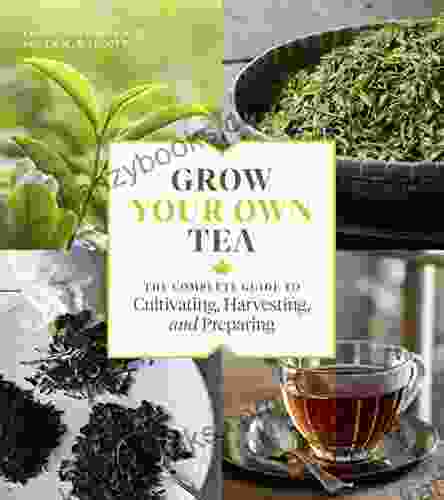Grow Your Own Tea: A Beginner's Guide to Cultivating Your Own Aromatic Brew

Tea, a beverage synonymous with comfort, relaxation, and countless cultural traditions, has captivated the world for centuries. While sipping a steaming cup of tea, few consider the origins of this beloved brew. However, growing your own tea plants offers a unique and rewarding experience, allowing you to savor the fresh, aromatic taste of homemade tea.
4.7 out of 5
| Language | : | English |
| File size | : | 37349 KB |
| Text-to-Speech | : | Enabled |
| Screen Reader | : | Supported |
| Enhanced typesetting | : | Enabled |
| Word Wise | : | Enabled |
| Print length | : | 208 pages |
| Lending | : | Enabled |
This comprehensive guide, "Grow Your Own Tea," empowers aspiring tea enthusiasts with the knowledge and techniques to cultivate their own tea plants. From selecting the right varieties to mastering harvesting and processing, we will delve into the intricacies of tea plant cultivation.
Choosing the Right Tea Plant Varieties
The first step in your tea-growing journey is selecting the appropriate tea plant varieties. Two main types of tea plants are commonly cultivated: Camellia sinensis, the source of all true teas (black, green, white, oolong, and pu-erh),and Camellia assamica, a hardier variety used for producing black tea.
When choosing a variety, consider your climate and growing conditions. C. sinensis prefers warm, humid climates, while C. assamica can tolerate cooler temperatures. Additionally, consider the desired flavor and aroma of your tea. Different varieties produce distinct flavors, from the delicate sweetness of green tea to the robust boldness of black tea.
Cultivating Your Tea Plants
Once you have selected your tea plant varieties, it's time to prepare your growing environment. Tea plants thrive in well-drained, acidic soil. Amend your soil with organic matter, such as compost or manure, to improve drainage and fertility.
Tea plants prefer partial shade, so choose a location that receives morning sun and afternoon shade. Plant your tea bushes 3-5 feet apart to allow for proper growth and air circulation.
Water your tea plants regularly, especially during hot, dry weather. Fertilize them monthly with a balanced fertilizer to support healthy growth.
Harvesting Your Tea Leaves
Tea leaves are typically ready to harvest 2-3 years after planting. The ideal time to harvest is when the leaves are young and tender, typically in the spring or early summer.
Use sharp, clean shears to carefully snip off the top two or three leaves from each stem. Handle the leaves gently to avoid bruising or damaging the delicate cells that contain the flavorful compounds.
Processing Your Tea Leaves
Once you have harvested your tea leaves, the next step is to process them. Processing methods vary depending on the desired type of tea. Here are the basic steps for processing black, green, and oolong teas:
Black Tea
- Withering: Spread the harvested leaves on a tray in a cool, dry place to reduce their moisture content.
- Rolling: Roll the withered leaves by hand or machine to break down the cell walls and release the flavor compounds.
- Oxidation: Expose the rolled leaves to air for a controlled period of time, allowing them to oxidize and develop their characteristic dark color and robust flavor.
- Drying: Heat the oxidized leaves in an oven or dehydrator to remove any remaining moisture.
Green Tea
- Steaming: Steam the harvested leaves to stop the oxidation process and preserve their green color.
- Drying: Pan-fry or dry the steamed leaves in an oven or dehydrator to remove moisture.
Oolong Tea
- Partial Oxidation: Allow the harvested leaves to oxidize for a shorter period than black tea, creating a semi-oxidized oolong tea with a unique flavor profile.
- Rolling and Drying: Roll and dry the partially oxidized leaves to complete the processing.
Enjoying Your Homemade Tea
After processing, your tea leaves are ready to brew and enjoy! To prepare a perfect cup of tea, use 1-2 teaspoons of tea leaves per 8 ounces of hot water. Steep for 3-5 minutes, or adjust the steeping time to your desired strength.
Savor the fresh, aromatic taste of your homemade tea, knowing that you have cultivated and processed it with your own hands. Whether you prefer the bold flavor of black tea, the delicate notes of green tea, or the complex nuances of oolong tea, growing your own tea plants offers a uniquely rewarding experience.
Growing your own tea plants is a journey of patience, dedication, and ultimately, great reward. By following the steps outlined in this guide, you can cultivate your own aromatic tea plants and enjoy the fresh, flavorful taste of homemade tea. Embrace the art of tea plant cultivation and discover the joy of sipping on a brew that you have nurtured from seed to cup.
4.7 out of 5
| Language | : | English |
| File size | : | 37349 KB |
| Text-to-Speech | : | Enabled |
| Screen Reader | : | Supported |
| Enhanced typesetting | : | Enabled |
| Word Wise | : | Enabled |
| Print length | : | 208 pages |
| Lending | : | Enabled |
Do you want to contribute by writing guest posts on this blog?
Please contact us and send us a resume of previous articles that you have written.
 Book
Book Novel
Novel Page
Page Chapter
Chapter Text
Text Story
Story Genre
Genre Reader
Reader Library
Library Paperback
Paperback E-book
E-book Magazine
Magazine Newspaper
Newspaper Paragraph
Paragraph Sentence
Sentence Bookmark
Bookmark Shelf
Shelf Glossary
Glossary Bibliography
Bibliography Foreword
Foreword Preface
Preface Synopsis
Synopsis Annotation
Annotation Footnote
Footnote Manuscript
Manuscript Scroll
Scroll Codex
Codex Tome
Tome Bestseller
Bestseller Classics
Classics Library card
Library card Narrative
Narrative Biography
Biography Autobiography
Autobiography Memoir
Memoir Reference
Reference Encyclopedia
Encyclopedia Jeff Alworth
Jeff Alworth Richard Hobbs
Richard Hobbs Swami Bhaskarananda
Swami Bhaskarananda Susan Hess
Susan Hess Stacy Rae
Stacy Rae Simona Simmons
Simona Simmons Joann Cleland
Joann Cleland Valentina Mylko
Valentina Mylko W Robert Nay
W Robert Nay Team Kindol Project
Team Kindol Project Kit Morgan
Kit Morgan Tasty
Tasty Mirav Tarkka
Mirav Tarkka Tamara Ferguson
Tamara Ferguson Sara Panton
Sara Panton Temika Mace Johnson
Temika Mace Johnson Scott Levy
Scott Levy Trudi Trueit
Trudi Trueit Tim Freke
Tim Freke Tarik Dervish
Tarik Dervish
Light bulbAdvertise smarter! Our strategic ad space ensures maximum exposure. Reserve your spot today!

 Jack PowellUnlock the Healing Power of Nature with Homeopathy Healing And You by Vinton...
Jack PowellUnlock the Healing Power of Nature with Homeopathy Healing And You by Vinton... Elias MitchellFollow ·5.2k
Elias MitchellFollow ·5.2k John UpdikeFollow ·7.5k
John UpdikeFollow ·7.5k Chad PriceFollow ·7k
Chad PriceFollow ·7k Cole PowellFollow ·14.3k
Cole PowellFollow ·14.3k Ryan FosterFollow ·11.2k
Ryan FosterFollow ·11.2k Neil GaimanFollow ·3.1k
Neil GaimanFollow ·3.1k Cristian CoxFollow ·6k
Cristian CoxFollow ·6k Albert CamusFollow ·11.2k
Albert CamusFollow ·11.2k

 Virginia Woolf
Virginia WoolfGetting High Fat Diet Easily Using Keto Fat Bomb Cookbook
Unveiling the Power of Fat...

 Milan Kundera
Milan KunderaAre You Cryin' Brian? Find the Inspiration and Humor in...
Life can be full of...

 Edmund Hayes
Edmund HayesUnlock Your Vitality: The 15-Day Natural Energy Boost...
Are You Ready to...

 Gavin Mitchell
Gavin MitchellMultiple Sclerosis Life Expectancy: Unveiling the Impact...
Multiple Sclerosis (MS) is a...

 Gabriel Garcia Marquez
Gabriel Garcia MarquezGet The Thighs That Can Crack Man Head Like Walnut
Are you tired of weak, flabby...
4.7 out of 5
| Language | : | English |
| File size | : | 37349 KB |
| Text-to-Speech | : | Enabled |
| Screen Reader | : | Supported |
| Enhanced typesetting | : | Enabled |
| Word Wise | : | Enabled |
| Print length | : | 208 pages |
| Lending | : | Enabled |











